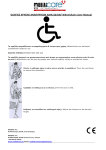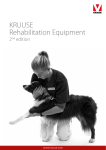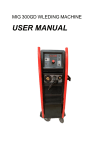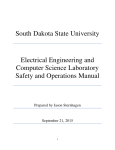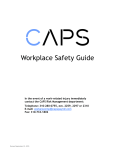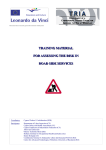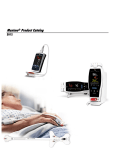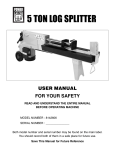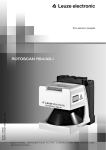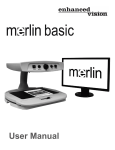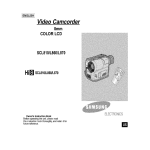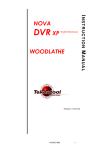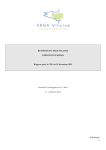Download IIPP - UC Davis Center for Neuroscience
Transcript
CENTER FOR NEUROSCIENCE UC DAVIS CENTER FOR NEUROSCIENCE INJURY AND ILLNESS PREVENTION PROGRAM This Injury and Illness Prevention Program has been prepared by the University of California, CENTER FOR NEUROSCIENCE department in accordance with University Policy (UCD Policy & Procedure Manual Section 290-15: Safety Management Program) and California Code of Regulations Title 8, Section 3203 (8 CCR, Section 3203). Revised July 2015 2 UC DAVIS CENTER FOR NEUROSCIENCE INJURY AND ILLNESS PREVENTION PROGRAM TABLE OF CONTENTS Preface Department Information I. Authorities and Responsible Parties II. System of Communications III. System for Assuring Employee Compliance with Safe Work Practices IV. Hazard Identification, Evaluation, and Inspection V. Accident Investigation VI. Hazard Correction VII. Health and Safety Training VIII. Recordkeeping and Documentation IX. Resources APPENDICES A. Hazard Alert/Correction Form B. Job Safety Analyses C. Worksite Inspection Forms D. Injury and Illness Investigation Form E. Safety Training Attendance Record Revised July 2015 3 Department Information Department Name: CENTER FOR NEUROSCIENCE Department Director: CAMERON CARTER, MD Address: 1544 NEWTON CT, DAVIS, CA 95618 Telephone Number: (530) 757-8708 Buildings Occupied by Department 1. Building: 1544 NEWTON CT, DAVIS, CA95618 Unit(s): CENTER FOR NEUROSCIENCE Contact: Phone: SUSAN SAINZ/LISA LAUGHLIN (530) 752-4484/(530) 757-8905 2. Building: 1515 NEWTON CT, DAVIS, CA 95618 Unit(s): SCHOOL OF MEDICINE, NEUROSCIENCES Contact: Phone: SUSAN SAINZ/LISA LAUGHLIN (530) 752-4484/(530) 757-8905 3. Building: 1633 DAVINCI CT, DAVIS, CA 95618 Unit(s): CENTER FOR NEUROSCIENCE Contact: Phone: SUSAN SAINZ/LISA LAUGHLIN (530) 752-4484/(530) 757-8905 4. Building: AVIAN SCIENCE FIELD BUILDING 747 HOPKINS RD, DAVIS, CA 95616 Unit(s): CENTER FOR NEUROSCIENCE Contact: Phone: SUSAN SAINZ/LISA LAUGHLIN (530) 752-4484/(530) 757-8905 Revised July 2015 4 II. System of Communications 1. Effective communications with CENTER FOR NEUROSCIENCE employees have been established using the following methods: Standard Operating Procedures Manual Material Safety Data Sheets Monthly departmental operations meetings Internal media (department intranet) EH&S Safety Nets Training videos Safety Newsletter Handouts Building Evacuation Plan E-mail Posters and warning labels Job Safety Analysis – Initial Hire Job Safety Analysis – Annual Review Other (list): Center for Neuroscience Safety Website Linked Within the Center for Neuroscience Website Quarterly Center for Neuroscience Safety Meetings with Laboratory Managers 2. Employees are encouraged to report any potential health and safety hazard that may exist in the workplace. Hazard Alert/Correction Forms (Appendix A) are available to employees for this purpose. Forms are to be placed in the Safety Coordinator’s departmental mail box. Employees have the option to remain anonymous when making a report. 3. Employees have been advised of adherence to safe work practices and the proper use of required personal protective equipment. Conformance will be reinforced by discipline for non-compliance in accordance with University policy (UC Davis Personnel Policies for Staff Members- Section 62, Corrective Action). Revised July 2015 6 III. System for Assuring Employee Compliance with Safe Work Practices Employees have been advised of adherence to safe work practices and the proper use of required personal protective equipment. Conformance will be reinforced by discipline for non-compliance in accordance with University policy (UC Davis Personnel Policies for Staff Members- Section 62, Corrective Action). The following methods are used to reinforce conformance with this program: 1. Distribution of Policies 2. Training Programs 3. Safety Performance Evaluations Performance evaluations at all levels must include an assessment of the individual's commitment to and performance of the accident prevention requirements of his/her position. The following are examples of factors considered when evaluating an employee's safety performance. • • • • • • • Adherence to defined safety practices. Use of provided safety equipment. Reporting unsafe acts, conditions, and equipment. Offering suggestions for solutions to safety problems. Planning work to include checking safety of equipment and procedures before starting. Early reporting of illness or injury that may arise as a result of the job. Providing support to safety programs. 4. Statement of non-compliance will be placed in performance evaluations if employee neglects to follow proper safety procedures, and documented records are on file that clearly indicate training was provided for the specific topic, and that the employee understood the training and potential hazards. 5. Corrective action for non-compliance will take place when documentation exists that proper training was provided, the employee understood the training, and the employee knowingly neglected to follow proper safety procedures. Corrective action includes, but is not limited to, the following: Letter of Warning, Suspension, or Dismissal. Revised July 2015 7 IV. Hazard Identification, Evaluation, and Inspection Job Hazard Analyses and worksite inspections have been established to identify and evaluate occupational safety and health hazards. 1. Job Safety Analysis: Job Safety Analysis (JSA) identifies and evaluates individual employee work functions, potential health or injury hazards, and specifies appropriate safe practices, personal protective equipment, and tools/equipment. JSA’s have been completed for the following job categories: A. 1544 NEWTON CT., DAVIS, CA 95618 • Job Safety Analysis for Office and Computer Workers • Job Safety Analysis for Laboratory Workers • Job Safety Analysis for Animal Handlers • Job Safety Analysis for Field Researchers • Job Safety Analysis for Shop Workers • B. 1515 NEWTON CT., DAVIS, CA 95618 • Job Safety Analysis for Office and Computer Workers • Job Safety Analysis for Laboratory Workers • Job Safety Analysis for Animal Handlers Job Safety Analysis for Shop Workers C. 1633 DAVINCI CT., DAVIS, CA 95618 • Job Safety Analysis for Office and Computer Workers • Job Safety Analysis for Laboratory Workers • Job Safety Analysis for Animal Handlers • Job Safety Analysis for Field Researchers • Job Safety Analysis for Shop Workers D. 747 HOPKINS RD., DAVIS, CA 95616 • Job Safety Analysis for Laboratory Workers • Job Safety Analysis for Animal Handlers • Job Safety Analysis for Field Researchers • Job Safety Analysis for Shop Workers The following resources are available for assistance in completing JSA’s: • • Laboratory personnel, please refer to the Laboratory Hazard Assessment Tool Non-Laboratory personnel, please refer to the JSA/PPE Certification Forms (Example JSAs are located in Appendix B1 and Appendix B2 of this template) Revised July 2015 8 2. Worksite Inspections Worksite inspections are conducted to identify and evaluate potential hazards. Types of worksite inspections include both periodic scheduled worksite inspections as well as those required for accident investigations, injury and illness cases, and unusual occurrences. Inspections are conducted at the following worksites: 1) Location: Frequency: Responsible Person: Records Location: 1544 Newton Ct., Davis, CA 95618 Annual Lisa Laughlin 1544 Newton Ct. Room 121 2) Location: Frequency: Responsible Person: Records Location: CNS Labs at 1515 Newton Ct., Davis, CA 95618 Annual Lisa Laughlin 1544 Newton Ct. Room 121 3) Location: Frequency: Responsible Person: Records Location: 1633 Davinci Ct.,Davis, CA 95618 Annual Lisa Laughlin 1544 Newton Ct. Room 121 4) Location: Frequency: Responsible Person: Records Location: 747 HOPKINS RD., DAVIS, CA 95616 Annual Lisa Laughlin 1544 Newton Ct. Room 121 Worksite Inspection Forms are located in Appendix C (C1 - General Office and C2 - Laboratory). (Example Worksite Inspection Forms are located in Appendix C of this template (C1 - General Office and C2 - Laboratory). Revised July 2015 9 V. Accident Investigation University Policy requires that work-related injuries and illnesses be reported to Workers’ Compensation within 24 hours of occurrence and state regulation requires all accidents be investigated. CENTER FOR NEUROSCIENCE employees will immediately notify their supervisor when occupationally-related injuries and illnesses occur, or when employees first become aware of such problems. 1. Supervisors will investigate all accidents, injuries, occupational illnesses, and near-miss incidents to identify the causal factors or attendant hazards. Appropriate repairs or procedural changes will be implemented promptly to mitigate the hazards implicated in these events. Proper injury reporting procedures can be found at http://safetyservices.ucdavis.edu/ps/rmwc/wcr/injuryReporting. The Injury and Illness Investigation Form (Appendix D) shall be completed to record pertinent information and a copy retained to serve as documentation. It can be completed by either the supervisor or the Department Safety Coordinator. 3. Note: Serious occupational injuries, illnesses, or exposures must be reported to Cal/OSHA by an EH&S representative within eight hours after they have become known to the supervisor. These include injuries/illnesses/exposures that cause permanent disfigurement or require hospitalization for a period in excess of 24 hours. Please refer to EH&S SafetyNet #121 for OSHA notification instructions. Revised July 2015 10 VI. Hazard Correction Hazards discovered either as a result of a scheduled periodic inspection or during normal operations must be corrected by the supervisor in control of the work area, or by cooperation between the department in control of the work area and the supervisor of the employees working in that area. Supervisors of affected employees are expected to correct unsafe conditions as quickly as possible after discovery of a hazard, based on the severity of the hazard. Specific procedures that can be used to correct hazards include, but are not limited to, the following: • Tagging unsafe equipment “Do Not Use Until Repaired,” and providing a list of alternatives for employees to use until the equipment is repaired. • Stopping unsafe work practices and providing retraining on proper procedures before work resumes. • Reinforcing and explaining the need for proper personal protective equipment and ensuring its availability. • Barricading areas that have chemical spills or other hazards and reporting the hazardous conditions to appropriate parties. Supervisors should use the Hazard Alert/Correction Report (Appendix A) to document corrective actions, including projected and actual completion dates. If an imminent hazard exists, work in the area must cease, and the appropriate supervisor must be contacted immediately. If the hazard cannot be immediately corrected without endangering employees or property, all personnel need to leave the area except those qualified and necessary to correct the condition. These qualified individuals will be equipped with necessary safeguards before addressing the situation. Revised July 2015 11 VII. Health and Safety Training Health and safety training, covering both general work practices and job-specific hazard training is the responsibility of the PRINCIPAL INVESTIGATOR and immediate Supervisor(s) as applicable to the following criteria: 1. Supervisors are provided with training to become familiar with the safety and health hazards to which employees under their immediate direction and control may be exposed. 2. All new employees receive training prior to engaging in responsibilities that pose potential hazard(s). 3. All employees given new job assignments receive training on the hazards of their new responsibilities prior to actually assuming those responsibilities. 4. Training is provided whenever new substances, processes, procedures or equipment (which represent a new hazard) are introduced to the workplace. 5. Whenever the employer is made aware of a new or previously unrecognized hazard, training is provided. The Safety Training Attendance Record form is located in Appendix E. Revised July 2015 12 VIII. Recordkeeping and Documentation Documents related to the CENTER FOR NEUROSCIENCE IIPP are maintained in/at/on: 1544 Newton Court, room 121, DEPARTMENT SAFETY COORDINATOR. The following documents will be maintained within the department’s IIPP Binder for at least the length of time indicated below: 1. Hazard Alert/Correction Forms (Appendix A form). Retain for three (3) years. 2. Employee Job Safety Analysis forms (Appendix B form) Retain for the duration of each individual’s employment. 3. Worksite Inspection Forms (Appendix C form). Retain for three (3) years. 4. Injury and Illness Investigation Forms (Appendix D form). Retain for three (3) years. The following documents will be maintained within the department’s IIPP Training Records Binder for at least the length of time indicated below: 1. Employee Safety Training Attendance Records (Appendix E form). Retain for three (3) years. Revised July 2015 13 IX. Resources X. Resources 1. UC Office of the President: Management of Health, Safety and the Environment, 10/28/05 2. UC Davis Policy and Procedure Manual, Section 290-15, Safety Management Program 3. California Code of Regulations Title 8, Section 3203, (8CCR §3203), Injury and Illness Prevention Program 4. Personnel Policies for Staff Members, Corrective Action, UC PPSM 62 5. UC Davis Environmental Health & Safety 6. • Safety Services Website • EH&S SafetyNets • Safety Data Sheets Safety Bulletin Board Postings: a. Cal/OSHA Poster-Health and Safety protection on the Job http://www.dir.ca.gov/dosh/dosh_publications/shpstreng012000.pdf b. UC Workers’ Compensation Poster http://safetyservices.ucdavis.edu/monthly-safetyspotlight/files-by-month/november-workers-comp/workers-compensation-poster 7. UC Davis Fire Prevention Services: http://fire.ucdavis.edu/wyn/fire-prevention-services 8. Additional Department Resources c. Center for Neuroscience Health and Safety Website http://neuroscience.ucdavis.edu/healthandsafety/ Signed copies of this document are on file in room 121 at 1544 Newton Ct. Revised July 2015 14 HAZARD ALERT / CORRECTION FORM Alert Identification No. ___________ Department: I. Unsafe Condition or Hazard Name: (optional) Job: Title: (optional) Location of Hazard: Building: Floor: Room: Date and time the condition or hazard was observed: Description of unsafe condition or hazard: What changes would you recommend to correct the condition or hazard? Employee Signature: (optional) Date: II. Management/Safety Committee Investigation Name of person investigating unsafe condition or hazard: Results of investigation (What was found? Was condition unsafe or a hazard?): (Attach additional sheets if necessary.) Proposed action to be taken to correct hazard or unsafe condition: (Complete and attach a Hazard Correction Report, IIPP Appendix E) Signature of Investigating Party: Date: IIPP-Appendix A Completed copies of this form should be routed to the appropriate supervisor and department December 2014 Safety Coordinator, and must be maintained in department files for at least three years. HAZARD ALERT / CORRECTION REPORT Alert Identification No. ___________ Department: This form should be used in conjunction with the “Hazard Alert Form” (IIPP Appendix A), as appropriate, to track the correction of identified hazards. All hazards should be corrected as soon as possible, based on the severity of the hazard. If a serious imminent hazard cannot be immediately corrected, evacuate personnel from the area and restrict access until the hazard can be addressed. Supervisor/Safety Coordinator Name: Telephone: Supervisor/Safety Coordinator Signature: Date: Description and Location of Unsafe Condition IIPP–Appendix A December 2014 Date Discovered Required Action and Responsible Party Completion Date Projected Actual Completed copies of this form should be routed to the department Safety Coordinator and kept in department files for at least three years. Effective: July 28, 2015 JOB SAFETY ANALYSIS DEPARTMENT: Center for Neuroscience JOB FUNCTION POTENTIAL HEALTH OR INJURY HAZARDS SAFE PRACTICE, OR EQUIPMENT General office work Back strain, eyestrain, repetitive motion injury General office work Physical injuries due to slips, trips and falls, and falling objects Ensure that workstations are ergonomically correct. Refer to EH&S SafetyNet #’s 17, 41, 46 and 96. Training and enforcement are under the direction of the Chief Administrative Officer. Keep floors clear of debris and liquid spills. If a spill can’t be cleaned immediately, use the "wet floor" sign to warn others of the potential hazard. Keep furniture boxes, etc. from blocking doorways, halls and walking space. Do not stand on chairs of any kind; use proper footstools or ladders. Do not store heavy objects overhead. Do not top-load filing cabinets, fill from bottom to top. Do not open more than one file drawer at a time. Brace tall bookcases and tall file cabinets to walls. Refer to EH&S SafetyNet # 46 and 83. Training and enforcement are under the direction of the Chief Administrative Officer. General office work Electrical hazards Do not use extension cords in lieu of permanent wiring. Ensure that high wattage appliances do not overload circuits. Replace frayed or damaged electrical cords. Ensure that electrical cords are not wedged against furniture or pinched by doors. Refer to EH&S SafetyNet # 109 and Electrical Safety Firenet at http://safetyservices.ucdavis.edu/ps/fp/fn/biefs/electricalS afety.pdf/view for additional information. Training and enforcement are under the direction of the Chief Administrative Officer. General office work. Physical injuries due to fires, earthquakes, bomb threats and workplace violence Attend emergency action and fire prevention plan training including emergency escape drills. Emergency Evacuation information is available at http://safetyservices.ucdavis.edu/ps/fp/fn/ee. Attend Workplace Violence training offered by UC Davis Police Department. Refer to EH&S SafetyNet # 83. Training and enforcement are under the direction of the Chief Administrative Officer. JSA Office Workers Revised 7/2015 _LL Appendix B1 1 JOB TYPE: Office / Computer Work PERSONAL PROTECTIVE EQUIPMENT (PPE) OR APPAREL Use of slip-resistant shoes may help prevent slips. Effective: July 28, 2015 JOB SAFETY ANALYSIS DEPARTMENT: Center for Neuroscience JOB FUNCTION POTENTIAL HEALTH OR INJURY HAZARDS SAFE PRACTICE, OR EQUIPMENT PERSONAL PROTECTIVE EQUIPMENT (PPE) OR APPAREL Ergonomic hazards including heavy lifting, repetitive motions, awkward motions, crushing or pinching injuries, etc Exposure to biological agents, chemical agents, and radiological items Get help with all loads that cannot be safely lifted by one person. Use mechanical means to lift and move heavy items, push carts and dolly rather than pull, employ proper lifting techniques at all times. Refer to EH&S SafetyNet #'s 29, 41 and 46. Training and enforcement are under the direction of the Chief Administrative Officer. . Training and enforcement are under the direction of the laboratory’s Principal Investigator (PI). Wear proper hand and foot protection to protect against crushing or pinching injuries. Handling and moving heavy items and equipment Entering a laboratory with biological, chemical, radiological agents JOB TYPE: Office / Computer Work • • JSA Office Workers Revised 7/2015 _LL Appendix B1 2 The minimum protective clothing includes full length pants, or equivalent, and closed toe/heel shoes must be worn at all times by all individuals who are occupying or entering a laboratory. The area of skin between the shoe and ankle should not be exposed Lab coats or protective garments are required to be worn while working with, or adjacent to, all bench top procedures using hazardous materials. Coats should be buttoned to their full length. Laboratory coat sleeves must be of sufficient length to prevent skin exposure while wearing gloves. Effective: July 28, 2015 JOB FUNCTION Entering the lab JOB SAFETY ANALYSIS POTENTIAL HEALTH OR INJURY HAZARDS • Exposure to biological agents, chemical agents, and radiological items. • DEPT: LOCATION: CNS Center for Neuroscience SAFE PRACTICE, OR EQUIPMENT Training and enforcement of entrance into labs and useage of necessary Personal Protective Equipment (PPE) are under the direction of the laboratory’s Principal Investigator (PI). JOB TYPE: Lab Worker PERSONAL PROTECIVE EQUIPMENT (PPE) • • JSA Lab Worker Revised 7/2015 _LL Appendix B2 1 The minimum protective clothing includes full length pants, or equivalent, and closed toe/heel shoes must be worn at all times by all individuals who are occupying or entering a laboratory. The area of skin between the shoe and ankle should not be exposed. Lab coats or protective garments are required to be worn while working with, or adjacent to, all bench top procedures using hazardous materials. Coats should be buttoned to their full length. Laboratory coat sleeves must be of sufficient length to prevent skin exposure while wearing gloves. Lab coats with cuffed sleeves are recommended. Effective: July 28, 2015 JOB FUNCTION Handling biological materials JOB SAFETY ANALYSIS POTENTIAL HEALTH OR INJURY HAZARDS • Exposure to biological agents via inhalation, contact, ingestion or injection. • • • • • • • • • JSA Lab Worker Revised 7/2015 _LL Appendix B2 DEPT: LOCATION: CNS Center for Neuroscience SAFE PRACTICE, OR EQUIPMENT Avoid unnecessary exposures. Practice proper personal hygiene (handwashing before and after working with biological hazard). Enroll in the Employee Health Services – Health Monitoring Program. Voluntary participation in Hepatitus B vaccination program. Attend EH&S Bloodborne Pathogen Program training, proper adherence to biological waste handling procedures, and familiarity with the EH&S BioSafety Manual. All personnel to conduct biological work and added to the BUA shall attend a class on Laboratory Biological Safety/Bloodborne Pathogen Program during the first 6 months of employment or of conducting this type of work. Know the location of the emergency eyewash station and shower nearest your lab. Refer to the Center for Neuroscience website: http://neuroscience.ucdavis.edu/healthandsafety/Labo ratoryWasteManangement.html - BiohazardousWaste, and EH&S SafetyNet #’s 16, 19 and 85. Training and enforcement are under the direction of the laboratory’s Principal Investigator (PI). 2 JOB TYPE: Lab Worker PERSONAL PROTECIVE EQUIPMENT (PPE) • Wear proper protective clothing, including gloves, protective eyewear and in some instances respiratory protection as necessary. • Wear additional protective equipment as documented in the Biological Use Authorization. Effective: July 28, 2015 JOB FUNCTION Handling chemicals JOB SAFETY ANALYSIS POTENTIAL HEALTH OR INJURY HAZARDS • Exposure to chemicals which may be corrosive, flammable, explosive, carcinogenic, or toxic such as HCl, NaOH, acetone, ethanol, picric acid, paraformaldehyde, etc. • • • • • • • • • • JSA Lab Worker Revised 7/2015 _LL Appendix B2 DEPT: LOCATION: CNS Center for Neuroscience SAFE PRACTICE, OR EQUIPMENT Avoid unnecessary exposures. Reduce exposures that cannot be avoided by minimizing exposure duration and concentration. Be familiar with what the Safety Data Sheets (SDS’s) state for the chemicals being used. Reduce risk by notifying the Department Safety Coordinator and EH&S of hazards. Use a fume hood when required by the SDS, SOP or by campus policy. Know the location of the emergency eyewash station and shower nearest your lab. Read and document training on the Building Evacuation Plan, participate in building fire drills. Refer to the Center for Neuroscience website: http://neuroscience.ucdavis.edu/healthandsafety/L aboratoryWasteManangement.html ChemicalWaste, and EH&S SafetyNet #’s 4, 5, 8, 13, 16, 19, 32, 42, 43, 45, 50, 60, 108 and other SafetyNets as appropriate to your laboratory. All personnel to receive training on Chemical Laboratory Safety, Hazardous Waste Management and Waste Minimization during the first 6 months of employment or of conducting this type of work. Training and enforcement are under the direction of the laboratory’s PI. 3 JOB TYPE: Lab Worker PERSONAL PROTECIVE EQUIPMENT (PPE) • • Wear protective clothing (goggles, mask, gloves, lab coat) as required by the MSDS, SOP, or campus policy. Always obtain an appropriate fit test prior to using an N95 respirator. Effective: July 28, 2015 JOB FUNCTION Cryogenic Liquids JOB SAFETY ANALYSIS POTENTIAL HEALTH OR INJURY HAZARDS • Exposure to cryogenic liquids • • • • Working with Class 1 Lasers (with a fully enclosed laser beam). • Working with Class 3b Lasers, during alignment or adjustment. • Present no health risk due to enclosed beam. Some ancillary hazards apply. • • • Class 3b lasers present a hazard to the eye from intrabeam viewing and specular reflection. • • • • JSA Lab Worker Revised 7/2015 _LL Appendix B2 DEPT: LOCATION: CNS Center for Neuroscience SAFE PRACTICE, OR EQUIPMENT Avoid unnecessary exposures Proper adherence to cryogenic procedures. Safety Net # 58 “Safety Precautions for Cryogenic Liquids” for more information. Training and enforcement are under the direction of the laboratory’s PI. JOB TYPE: Lab Worker PERSONAL PROTECIVE EQUIPMENT (PPE) • Proper selection and use of tools and protective clothing • Must wear eye protection that is appropriate to the type of laser. Do not operate laser equipment unless the person supervising the use of the equipment has trained you. Refer to EH&S SafetyNet #’s 73, 74, 75, 76 and 77. Training and enforcement are under the direction of the laboratory’s PI or manager. The door shall be locked and a sign placed on the door stating “Do Not Enter, Laser Alignment in progress.” Do not operate or adjust the laser equipment unless you have been trained by the Campus Laser Safety Officer from EH&S (Laser Safety Course), and have at least read the User’s Manual or have been trained by certified trainers. Refer to EH&S SafetyNet #’s 73, 74, 75, 76, and 77. Training and enforcement are under the direction of the PI in charge of the equipment. 4 Effective: July 28, 2015 JOB FUNCTION Working with Class 4 Lasers, during alignment or adjustment. JOB SAFETY ANALYSIS POTENTIAL HEALTH OR INJURY HAZARDS • • Antimicrobial disinfection. • Class 4 lasers present a hazard to the eye from intrabeam viewing, specular, and diffuse reflections. They can also cause thermal burns and start fires in the laboratory. Exposure to disinfectant chemicals. • • • • • • • • General office work. JSA Lab Worker Revised 7/2015 _LL Appendix B2 • Backstrain, eyestrain, repetitive motion injury. • • • DEPT: LOCATION: CNS Center for Neuroscience SAFE PRACTICE, OR EQUIPMENT The door shall be locked and a sign placed on the door stating “Do Not Enter, Laser Alignment in progress.” Do not operate or adjust the laser equipment unless you have been trained by the Campus Laser Safety Officer from EH&S (Laser Safety Course), and have at least read the User’s Manual or have been trained by certified trainers. Refer to EH&S SafetyNet #’s 73, 74, 75, 76, and 77. Training and enforcement are under the direction of the PI in charge of the equipment. See the MSDS for the chemical being used. Know the location of the emergency eyewash station and shower nearest your lab. Refer to EH&S SafetyNet #’s 16, 19 and 85. Training and enforcement are under the direction of the laboratory’s PI. Ensure that workstations are ergonomically correct. Refer to EH&S SafetyNet #’s 17, 41, 46 and 96. Training and enforcement are under the direction of the laboratory’s PI. 5 JOB TYPE: Lab Worker PERSONAL PROTECIVE EQUIPMENT (PPE) • Must wear eye protection that is appropriate to the type of laser. • Wear protective clothing and eyewear as per the MSDS, SOP or campus policy. Effective: July 28, 2015 JOB FUNCTION General office work. JOB SAFETY ANALYSIS POTENTIAL HEALTH OR INJURY HAZARDS • Physical injuries due to slips, trips and falls, and falling objects. • • • • • • • • • • General office work. • Electrical hazards. • • • • • JSA Lab Worker Revised 7/2015 _LL Appendix B2 DEPT: LOCATION: CNS Center for Neuroscience SAFE PRACTICE, OR EQUIPMENT Keep floors clear of debris and liquid spills. If a spill can’t be cleaned immediately, use the "wet floor" sign to warn others of the potential hazard. Keep furniture boxes, etc. from blocking doorways, halls and walking space. Do not stand on chairs of any kind; use proper footstools or ladders. Do not store heavy objects overhead. Do not top-load filing cabinets, fill bottom to top. Do not open more than one file drawer at a time. Brace tall bookcases and tall file cabinets to walls. Refer to EH&S SafetyNet # 46 and 83. Training and enforcement are under the direction of the laboratory's PI. Do not use extension cords in lieu of permanent wiring. Ensure that high wattage appliances do not overload circuits. Replace frayed or damaged electrical cords. Ensure that electrical cords are not damaged by being wedged against furniture or pinched doors. Refer to EH&S SafetyNet #’s 20 and 109. Training and enforcement are under the direction of the laboratory’s PI. 6 JOB TYPE: Lab Worker PERSONAL PROTECIVE EQUIPMENT (PPE) Effective: July 28, 2015 JOB FUNCTION General office work. JOB SAFETY ANALYSIS POTENTIAL HEALTH OR INJURY HAZARDS • Handling and • moving heavy items and equipment. JSA Lab Worker Revised 7/2015 _LL Appendix B2 DEPT: LOCATION: CNS Center for Neuroscience SAFE PRACTICE, OR EQUIPMENT Physical injuries • due to fires, earthquakes, bomb • threats and workplace • violence. • Be familiar with the emergency action and fire prevention plan including emergency escape drills. Attend Workplace Violence training offered by UC Davis Police Department. Refer to the “Center for Neuroscience Building Evacuation Plan” and EH&S SafetyNet # 83. Training and enforcement are under the direction of the laboratory’s PI. Ergonomic hazards including heavy lifting, repetitive motions, awkward motions, crushing or pinching injuries, etc. Get help with all loads that cannot be safely lifted by one person. Use mechanical means to lift and move heavy items; push carts and dolly rather than pull; employ proper lifting techniques at all times. Wear proper hand and foot protection to protect against crushing or pinching injuries. Refer to EH&S SafetyNet #’s 29, 41 and 46. Training and enforcement are under the direction of the laboratory’s PI. • • • • • 7 JOB TYPE: Lab Worker PERSONAL PROTECIVE EQUIPMENT (PPE) Effective: July 28, 2015 JOB FUNCTION JOB SAFETY ANALYSIS POTENTIAL HEALTH OR INJURY HAZARDS Animal Mechanical/Physical Handling and Injuries from Animals. Restraint • • • • • JSA Animal Handler Revised 7/2015 _LL Appendix B3 DEPT: LOCATION: CNS Center for Neuroscience SAFE PRACTICE, OR EQUIPMENT Training for handling animals can be obtained from the Laboratory Animal Skills Class or from your supervisor. Do not perform a procedure for which you have not been trained or feel uncomfortable. Ask your supervisor for assistance. Always keep in mind that animals may bite, scratch or grab (in the case of primates). Maintain a safe distance from them when possible. Follow any Standard Operating Procedures (SOP) that your supervisor provides. (If you are working with primates, you will be required to watch a video such as, “Working Safely with Nonhuman Primates” and complete the online toonosis training course. Prior to beginning work in a lab.) Immediately report any accident or injury to your supervisor and to Occupational Health Services at (530) 752-6051. 1 JOB TYPE: Animal Handler PERSONAL PROTECIVE EQUIPMENT (PPE) • • When working with species other than primates, the minimum protective clothing requirement is a lab coat, gloves, long pants and closed-toed shoes. The laboratory or experimental conditions dictate any other requirements. For instance, if dust or fluid is generated (or if there is a potential for splash), wear a mask and eye protection. When working with monkeys, long pants and a lab coat coat with cuffed sleeves (or “sleeves” with an uncuffed lab coat) will help protect against scratches. In some situations, you may be required to wear thick, protective leather gloves. See the Zoonotic Exposure section for more information. Effective: July 28, 2015 JOB FUNCTION JOB SAFETY ANALYSIS POTENTIAL HEALTH OR INJURY HAZARDS Animal Zoonotic Exposures: Handling and Zoonotic diseases are Restraint infections or infestations shared by humans and animals. Be aware that these diseases may also be transmitted via animal tissues (blood, neural tissue, etc.). Animal Zoonotic Exposure or Handling and Mechanical/Physical Restraint Injuries from Animals JSA Animal Handler Revised 7/2015 _LL Appendix B3 DEPT: LOCATION: CNS Center for Neuroscience SAFE PRACTICE, OR EQUIPMENT Before beginning work, review the information on the following link: http://safetyservices.ucdavis.edu/ps/occh/acuohp/pem/sta yingHealthy_Vivarium Use the “Hazard Analysis Tool” to obtain current information on zoonotic diseases for the species with which you will be working: http://safetyapps.ucdavis.edu/IACUC/risktool/index.cfm . Also review the information on “Allergy to Animals:” http://safetyservices.ucdavis.edu/ps/occh/acuohp/pem/all ergyToAnimals?searchterm=allergy+to+animals Everyone who has exposure to animals must complete the “Significant Biological Agent or Animal Contact Health Surveillance Questionnaire. “ Health care professionals at Occupational Health Services will review the form and make individual recommendations as appropriate. • No food or drink is allowed into the lab (or beyond the first controlled access door i.e. beyond the door between the lobby and the lab areas). • Wash hands with soap before exiting animal and lab areas and after working with animals. • For personnel working with primates, the above listed safe practices, are required. • Immediately report any accident or injury to your supervisor and to Occupational Health Services at (530) 752-6051. 2 JOB TYPE: Animal Handler PERSONAL PROTECIVE EQUIPMENT (PPE) • If you suffer from allergies to a species you must work with, consider wearing an approved, NIOSH certified N95 respirator when in the animal facility. Respirators are, in general, less effective than the other methods shown above and should not be used as a substitute for good work place hygiene. • Closed-toed shoes are to be worn in the lab (or beyond the first controlled access door). When working with animals, wear lab coat and other appropriate protective equipment stated above. For personnel working with primates, the above listed protective apparel, or equipment are required. • • Effective: July 28, 2015 JOB FUNCTION Field Research JOB SAFETY ANALYSIS POTENTIAL HEALTH OR INJURY HAZARDS Exposure to sun/elevated temperatures (heat illness training applies for temperatures at or above 80oF) • • Other weather conditions Access to field sites JSA Field researcher Revised 7/2015 _LL Appendix B4 DEPT: LOCATION: CNS Center for Neuroscience SAFE PRACTICE, OR EQUIPMENT • New Heat Illness Guidelines effective starting May 2015. http://safetyservices.ucdavis.edu/newsitems/heatillnessnews For exposure to sun/heat: Wear sunscreen and hat. Maintain adequate fluid intake. For further information, read Safety Net # 123 and the Heat Illness Prevention Manual at http://safetyservices.ucdavis.edu/ps/ghs/hi/heatIll ness_Information • Other adverse weather: Wear protective clothing as needed (hat, raincoat, gloves, appropriate footwear). Take cover during a thunderstorm. • Drive defensively. Avoid driving when tired. Be prepared for delays. Carry adequate food, water, clothing, first aid equipment and tools. 1 JOB TYPE: Field Researcher PERSONAL PROTECIVE EQUIPMENT (PPE) For exposure to sun/heat: Wear hat, seek frequent shade for temperatures at or above 80oF. Effective: July 28, 2015 JOB FUNCTION JSA Field researcher Revised 7/2015 _LL Appendix B4 JOB SAFETY ANALYSIS POTENTIAL HEALTH OR INJURY HAZARDS DEPT: LOCATION: CNS Center for Neuroscience SAFE PRACTICE, OR EQUIPMENT Field Activities • Wear appropriate footgear, especially when traveling through rough or rocky terrain. Obtain appropriate training on equipment use. Travel with another individual when accessing remote locations. Provide supervisor with itinerary prior to trip. Valley Fever: Valley fever is another name for the sometimes-deadly infection coccidioidomycosis. It is called valley fever because the organism that causes it is commonly found in the soil of the southwestern United States, Mexico, and parts of Central and South America. Valley fever usually affects the lungs. When it affects other parts of the body, it is called disseminated valley fever. Valley fever is spread through the • Persons at risk for valley fever should avoid exposure to dust and dry soil in areas where valley fever is common. Avoid working in windy/dusty conditions. • 2 JOB TYPE: Field Researcher PERSONAL PROTECIVE EQUIPMENT (PPE) • Wear particle dust mask (if at risk for valley fever) Effective: July 28, 2015 JOB FUNCTION JOB SAFETY ANALYSIS POTENTIAL HEALTH OR INJURY HAZARDS DEPT: LOCATION: CNS Center for Neuroscience SAFE PRACTICE, OR EQUIPMENT air. If soil containing the valley fever fungus is disturbed by construction, natural disasters, or wind, the fungus spores get into the air. People can breathe in the spores and get valley fever. The disease is not spread from person to person. Anyone can get valley fever, but people who engage in activities that disturb the soil are at increased risk. People with weakened immune systems are at increased risk for disseminated disease. JSA Field researcher Revised 7/2015 _LL Appendix B4 3 JOB TYPE: Field Researcher PERSONAL PROTECIVE EQUIPMENT (PPE) Effective: July 28, 2015 JOB FUNCTION Instructions for use of all toolsPreparation Instructions for use of all tools- Use JOB SAFETY ANALYSIS POTENTIAL HEALTH OR INJURY HAZARDS • Trips/Falls • Flying Parts • Bodily Injury • Fires or Electrical Shocks DEPT: LOCATION: CNS Center for Neuroscience SAFE PRACTICE, OR EQUIPMENT • • • • • • • • • • JSA Shop Worker Revised 7/2015 _LL Appendix B5 • Tangled Parts • • Bodily Injury • • Eye Injury Back Strain • • • • • JOB TYPE: Shop Worker PERSONAL PROTECIVE EQUIPMENT (PPE) Clean work area before starting. Make sure area is well lit. Secure and tighten all parts before starting. Use proper tool accessories. Check and replace any broken or damaged parts. • Long pants, Non-slip, Closed-Toe Shoes • Dust Mask • Goggles/Safety Glasses • Remove jewelry from hands and neck, tie back hair, roll up long sleeves and secure any other loose clothing that could potentially get caught in moving equipment. Don’t operate tools in explosive atmospheres. Grounded tools must be plugged into properly installed grounded outlets. Do not force polarized plugs into an outlet if it won’t fit. Avoid body contact with grounded surfaces. Don’t expose power tools to rain or wet conditions. Disconnect the plug from power source before making any adjustments or changing accessories. Do not wear loose clothing or jewelry. Tie long hair. Wear goggles or any eye protection. Do not overreach. Keep feet shoulder length apart. • Long pants, Non-slip, Closed-Toe Shoes • Dust Mask • Goggles/Safety Glasses • Remove jewelry from hands and neck, tie back hair, roll up long sleeves and secure any other loose clothing that could potentially get caught in moving equipment. 1 Effective: July 28, 2015 JOB FUNCTION JOB SAFETY ANALYSIS POTENTIAL HEALTH OR INJURY HAZARDS Instructions for use of all tools- After Use • Bodily Injury • Electrical Shocks General machining and metal fabrication processes using stationary machine tools; (lathe, mill, drill press, and grinders) • JSA Shop Worker Revised 7/2015 _LL Appendix B5 DEPT: LOCATION: CNS Center for Neuroscience SAFE PRACTICE, OR EQUIPMENT Keep sharp cutting edges clean. Lubricate tool, if necessary. Use air compression to clean tool, if necessary. Do not store tools in an area where water can enter. • Long pants, Non-slip, Closed-Toe Shoes • Dust Mask • Goggles/Safety Glasses • Remove jewelry from hands and neck, tie back hair, roll up long sleeves and secure any other loose clothing that could potentially get caught in moving equipment. • Students, staff, and faculty using the machine shop must have prior authorization and complete the CNS machine shop safety online training. Go to this link for training, http://neuroscience.ucdavis.edu/healthandsafet y/ShopSafety.html • Use tools according to manufacturer’s recommendation. • Understand use of tools and procedures before commencing work. • Use correct tool for the job and ensure that tools are in good condition before starting work. • Report any defect tool or machine to Safety Manager. • Use the guarding systems and shields. • Do not defeat guarding systems • Long pants, Non-slip, Closed-Toe Shoes • Dust Mask • Goggles/Safety Glasses • Remove jewelry from hands and neck, tie back hair, roll up long sleeves and secure any other loose clothing that could potentially get caught in moving equipment. • Wear hearing protection. • • • • Cuts, contusions, lacerations, from contact with point of operation or associated flying materials from work part. • Hearing damage from audible noise above 90dB at a sustained level: Hours per Sound level day 8 90dB 6 92dB 4 95dB 3 97dB 2 100dB 1.5 102dB JOB TYPE: Shop Worker PERSONAL PROTECIVE EQUIPMENT (PPE) 2 Effective: July 28, 2015 JOB FUNCTION JOB SAFETY ANALYSIS POTENTIAL HEALTH OR INJURY HAZARDS 1 105dB .5 110dB .25 or less 115dB Grinding • • Metal dust, silica dust Noise Exposure to cutting fluid and fumes • • Dermatitis Inhalation hazard JSA Shop Worker Revised 7/2015 _LL Appendix B5 DEPT: LOCATION: CNS Center for Neuroscience SAFE PRACTICE, OR EQUIPMENT • Use tools according to manufacturer’s recommendation. • Understand use of tools and procedures before commencing work. • Use correct tool for the job and ensure that tools are in good condition before starting work. • Report any defect tool or machine to Safety Manager. • • JOB TYPE: Shop Worker PERSONAL PROTECIVE EQUIPMENT (PPE) • Long pants, Non-slip, Closed-Toe Shoes • Use dust masks or respirators as appropriate. • Goggles/Safety Glasses and Face Shields. • Remove jewelry from hands and neck, tie back hair, roll up long sleeves and secure any other loose clothing that could potentially get caught in moving equipment. • Wear hearing protection. • Use ear protection Limit skin exposure and wash affected area with • May require use of a soap and water. respirator. Please vist the informational link on Use ventilation when operation generates the respirator fit program fumes. at http://safetyservices.ucda vis.edu/newsitems/breathing-easierthe-respirator-fit-program 3 Effective: July 28, 2015 JOB FUNCTION Use of oils and lubricants JOB SAFETY ANALYSIS POTENTIAL HEALTH OR INJURY HAZARDS • • Use of hand tools • DEPT: LOCATION: CNS Center for Neuroscience SAFE PRACTICE, OR EQUIPMENT Spontaneous combustion from wiping cloths saturated with oil Slip hazard from spilled oil and cutting fluids Cuts, abrasions, contusions from contact with point of operation • • • • • • • Dispose of oily cloths in safety can. Keep work area clean. Keep away from ignition sources. Keep fire extinguishers up to date. Store in flammable cabinets JOB TYPE: Shop Worker PERSONAL PROTECIVE EQUIPMENT (PPE) • Use the proper tool for the job Report unsafe tools to the Facility/Safety Manager Consult SDS’s for details on recommended PPE. • • Hazardous materials • • Fumes from solvents, paint Fumes and particulates from epoxy composite fabrication • • • • • • • • JSA Shop Worker Revised 7/2015 _LL Appendix B5 Read and observe information from SDS's. Use adequate ventilation. Keep away from ignition sources. Use approved respirator; training class and medical exam required before use. Keep fire extinguishers up to date. Cover exposed body surfaces when sanding epoxy composites Store in flammable cabinets Dispose waste according to UC Davis Hazardous Waste policies and procedures. 4 • • Wear safety glasses and face shields if there is a risk of flying debris. Consult equipment user guides for any other PPE recommendations. Observe recommended use of PPE from SDS’s for chemical being used. Consult Safety Net #50Guidelines for the Selection of Chemical Resistant Gloves. WORKSITE INSPECTION FORM General Office Environment Location: Date: Inspector: Phone: Department: Administration and Training Yes No NA 1. Yes No NA 2. Yes No NA 3. Yes No NA 4. Yes No NA 5. Yes No NA 6. Are all safety records maintained in a centralized file for easy access? Are they current? Have all employees attended Injury & Illness Prevention Program training? If not, what percentage has attended? _______________ Does the department have a completed Emergency Action Plan? Are employees being trained on its contents? Are chemical products used in the office being purchased in small quantities? Are Material Safety Data Sheets needed? Are the Cal/OSHA information poster, Workers’ Compensation bulletin, annual accident summary posted? Are annual workplace inspections performed and documented? General Safety Yes No NA 7. Yes No NA 8. Yes No NA 9. Yes No NA 10. Yes No NA 11. Yes No NA 12. Yes No NA 13. Yes No NA 14. Are exits, fire alarms, pullboxes clearly marked and unobstructed? Are aisles and corridors unobstructed to allow unimpeded evacuations? Is a clearly identified, unobstructed, charged, currently inspected and tagged, wall-mounted fire extinguisher available as required by the Fire Department? Are ergonomic issues being addressed for employees using computers or at risk of repetitive motion injuries? Is a fully stocked first-aid kit available? Is the location known to all employees in the area? Are cabinets, shelves, and furniture over five feet tall secured to prevent toppling during earthquakes? Are books and heavy items and equipment stored on low shelves and secured to prevent them from falling on people during earthquakes? Is the office kept clean of trash and recyclables promptly removed? Electrical Safety Are plugs, cords, electrical panels, and receptacles in good Yes No NA Yes No NA 15. condition? No exposed conductors or broken insulation? 16. Are circuit breaker panels accessible and labeled? Yes No NA 17. with an automatic circuit breaker, have cords no longer than 15 feet Yes No NA 18. Is lighting adequate throughout the work environment? Yes No NA 19. through walls, doors, ceiling, or present a trip hazard. Yes No NA 20. listed, plugged directly into a wall outlet, and located away from IIPP-Appendix C1-Office December 2014 Are surge protectors being used? If so, they must be equipped in length, and be plugged directly into a wall outlet. Are extension cords being used correctly? They must not run Are portable electric heaters being used? If so, they must be UL combustible materials. Completed copies of this form should be routed to the department Safety Coordinator and must be maintained in department files for at least three years. University of California, Davis Laboratory Self-Inspection Checklist Principal Investigator/Laboratory Supervisor: ___________________________________ Laboratories Reviewed: ____________________________________________________ Date: ____________ Reviewer: __________________________________ I. Revised 1/2015 SAFETY PROGRAM ADMINISTRATON A. Chemical Hygiene Plan Yes No N/A Yes No N/A Yes No N/A Yes No N/A Yes No N/A 1. Does the laboratory have access to the campus-wide Chemical Hygiene Plan and all of the required elements? 2. Are there any operations that require prior approval before beginning (e.g.., Radiation Safety, Bio-safety committee)? B. Illness and Injury Prevention Plan 1. Does laboratory have access to Department IIPP and has it been reviewed in past year? 2. Is there documentation that all laboratory personnel have trained on IIPP? C. Standard Operating Procedures (SOP’s) 1. Are there written SOP’s covering the laboratory processes and hazardous chemicals referenced in Title 8 (i.e., acutely toxic substances, reproductive toxins, and regulated carcinogens)? 2. Are there exemptions to the written SOPs and are these documented? 3. Training of laboratory personnel documented. 4. Required specialized training complete and documented. 5. Training is current with Chemical Hygiene Plan. 6. Training is complete on Hazardous waste management. 7. Training is complete on Blood borne Pathogen requirements. II. HAZARDOUS MATERIALS 1. Laboratory doors are labeled with emergency contact notification names & numbers, hazards present & necessary precautions. 2. Labels are clean and intact on all chemical containers. 3. Chemical containers are clearly identified with contents and hazards. 4. Containers with non-hazardous substances (i.e., water) clearly labeled to avoid confusion. A. Chemical Controls Notes:___________________________________________________________________________ ________________________________________________________________________________ ________________________________________________________________________________ ________________________________________________________________________________ ____________________________________________________________________________ Pg. 1 1. Chemicals are not stored on laboratory benches in excessive quantities. 2. Expired or chemicals not used (for more than one year) are disposed of as hazardous waste. 3. Secondary containment is provided for strong acids and strong bases. 4. Incompatible chemicals are segregated and stored with compatible hazard classes. 5. All chemical containers are closed, except when actively adding or removing materials from them (i.e., no open funnels left in container). 6. Containers of peroxide-forming chemicals are dated upon receipt and disposed of as hazardous waste within one year of receipt. 7. Safety Data Sheets (SDS) and laboratory chemical inventory are up-to-date and readily available. 8. Chemicals (liquids) are stored below eye level and not directly on the floor, unless in secondary containment. 9. Dedicated chemical storage (cabinets, refrigerators, freezers) clearly labeled with contents and hazard warnings. B. Flammable & Combustible Liquids Yes No N/A Yes No N/A Yes No N/A 1. Flammable liquids stored in 1-gallon or smaller containers or kept in 2-gallon or smaller safety cans. 2. Flammable liquids (including flammable liquid waste) stored outside of a storage cabinet does not exceed 10 gallons. 3. If more than 10 gallons of flammable liquids are present does the laboratory have an approved flammable storage cabinet? 4. Flammable liquids, stored in flammable storage cabinets limited to 60 gallons per fire rated area. 5. Flammable liquids requiring reduced temperature stored in flammable-rated refrigerator/freezer. C. Particularly Hazardous Substances 1. Have all particularly hazardous substances been identified? 2. Designated area(s) for acutely toxic materials, reproductive toxins and/or carcinogens clearly marked. 3. Are all users adequately trained? Documentation available? 4. All necessary PPE (personal protective equipment) available and used as needed. D. Radioactive Materials 1. Stock materials of radioactive materials are secured against unauthorized removal? 2. Do personnel wear lab coats and gloves when handling radioactive materials? If assigned dosimeters, are they wearing them? Notes:___________________________________________________________________________ ________________________________________________________________________________ ________________________________________________________________________________ ________________________________________________________________________________ ____________________________________________________________________________ Pg. 2 3. Are all radioactive materials registered with the EH&S Health Physics Program? 4. Radioactive Waste – Properly labeled, segregated, and shielded? III. CHEMICAL WASTE A. Storage Yes No N/A Yes No N/A Yes No N/A Yes No N/A Yes No N/A 1. Are chemical waste containers properly segregated, sealed with tight-fitting caps and stored with EH&S Hazardous Waste Labels attached? 2. All hazardous chemical waste is arranged to be picked up by EH&S — not drain disposed or evaporated. 3. Hazardous chemical waste has been accumulating for less than 270 days. Extremely hazardous waste has been accumulating less than 90 days. 4. All hazardous chemical waste is secondary contained. 5. Training for personnel handling hazardous waste is documented? 6. EH&S is called for waste pick up when containers are full (90% capacity or full line) or have reached their accumulation date threshold. 7. Waste containers sturdy, compatible with the waste, routinely checked for leaks and kept closed when not actively being filled. B. Labeling 1. All hazardous waste containers have the proper labels with contents and accumulation start date. 2. The hazardous waste accumulation area is clean with waste containers clearly marked. IV. BIOHAZARDOUS WASTE A. Storage 1. Solid bio hazardous waste is bagged in red polyethylene bags as per the Medical Waste Management Plan. 2. Bio hazardous liquid waste is managed per the Medical Waste Management Plan. 3. Sharps stored in puncture-proof containers and labeled appropriately, not past fill line. B. Labeling 1. Secondary containers for laboratory medical waste storage or transport labeled with the international biohazard symbol and the word “Biohazard.” V. PERSONAL HEALTH AND SAFETY A. Food and Drink 1. Sinks labeled “Industrial Water – Do Not Drink”. 2. Food and drink is not permitted in laboratories. 3. Food and drink is stored only in refrigerators/freezers dedicated and labeled “for food only”. Notes:___________________________________________________________________________ ________________________________________________________________________________ ________________________________________________________________________________ ________________________________________________________________________________ ____________________________________________________________________________ Pg. 3 B. Standard Practices Yes No N/A Yes No N/A Yes No N/A Yes No N/A Yes No N/A 1. Employees wash areas of exposed skin prior to leaving the laboratory. 2. Sink is available and hands washed after removing gloves and before leaving laboratory. 3. Cosmetic applications, taking medication, touching eyes, nose or mouth avoided in laboratory. VI. HEALTH AND SAFETY EQUIPMENT A. Safety Showers and Eye Washes 1. Approved safety showers and eye washes provided within 10 seconds travel time from the work area for immediate use, with no barriers (i.e. doors) for use or storage of corrosives. 2. All eyewashes and showers have unobstructed access. 3. Units inspected and activated monthly. Annually certification by Facilities Management for proper functioning. 4. Sign indicating location of safety shower and eye wash unobstructed. B. Personal Protective Equipment 1. Has the correct PPE been selected based on a hazard assessment or SDS recommendation? 2. PPE required for laboratory work: ( ) Lab Coats, ( ) Safety glasses with side shields/goggles, ( ) Hearing protection, ( ) Face Shield, ( ) Proper foot-wear, ( ) Gloves, ( ) Aprons 3. All necessary equipment is available, in good condition, and properly used. C. Laboratory Fume Hoods 1. Storage inside of hood is kept to a minimum. 2. Equipment in use does not interfere with proper functioning of the hood. 3. All work is done at least 6 inches inside hood. 4. Front sash is lowered when hood is not in use. 5. Certified annually by Facilities Management, semiannually for Title 8 §5209 “listed” Carcinogens. 6. Hood has continuous flow monitor. 7. The back ventilation slot is not obstructed. 8. Drains are protected from hazardous materials entering. D. Biological Safety Cabinet 1. Certified within the last year. 2. Proper type of hood for work being conducted. 3. Equipment is properly labeled for the hazard present (radiation, UV,), Manufacturer approved for hazard. 4. Hood ducted per manufacturer and ASHRAE requirements and meets the bio-safety specifications. Notes:___________________________________________________________________________ ________________________________________________________________________________ ________________________________________________________________________________ ________________________________________________________________________________ ____________________________________________________________________________ Pg. 4 E. Compressed Gas Cylinders Yes No N/A Yes No N/A Yes No N/A Yes No N/A 1. Cylinders stored in well protected, well vented and dry locations away from combustible materials. 2. Flammable gases stored away from oxidizers. 3. Cylinders are secured to a rigid structural component of the building with non-flammable restraints located 1/3 and 2/3 (preferred) or ½ the height of the cylinder. 4. Protective caps in place while cylinders are in storage and full/empty tags attached. 5. Proper regulators are being used and closed when cylinders are not in use. F. Housekeeping & Miscellaneous Laboratory Safety 1. Bench tops clean, organized and environs maintained to eliminate harmful exposures or unsafe conditions. 2. Supplies stored at minimum of 24 inches from ceiling and off the floor. 3. Vacuum lines equipped with traps designed specifically to accumulate/filter the hazardous materials being evacuated. 4. All moving machinery (i.e., vacuum pumps) belts adequately protected by a rigid belt guard or housing. 5. All sharps disposed properly. 6. The condition of the broken glass box is adequate and placed out of the way. 7. Ceiling tiles present and in good condition. 8. Refrigerators/freezers labeled according to use. G. Electrical Safety 1. High voltage equipment (>600V) labeled, grounded and insulated. 2. No equipment has damaged or frayed cords. 3. Extension cords are not connected together. 4. Power strips used only if they are equipped with circuit breakers. 5. All equipment is grounded via 3-prong plugs. 6. Damaged equipment tagged out to prevent use. H. General Safety 1. Cabinets and bookshelves are secured. 2. Overhead storage is minimized and restrained from falling (i.e., shelf lips, rails). 3. Heavy equipment is secured or braced from falling. I. Respiratory Protection 1. Use of respiratory protection conforms to UC Davis Policy. Yes No N/A 2. Respirators are inspected monthly and before use. Notes:___________________________________________________________________________ ________________________________________________________________________________ ________________________________________________________________________________ ________________________________________________________________________________ ____________________________________________________________________________ Pg. 5 3. The user has been fit tested by the Occupational Health Services. 4. Cartridges are changed on designated schedule and are the appropriate cartridge for the hazard. J. Laser Safety Yes No N/A Yes No N/A Yes No N/A Yes No N/A Yes No N/A 1. Does the laboratory use any Class 3b or 4 lasers? 2. Are the lasers registered with EH&S Health Physics Program? 3. Are the Standard Precautions for lasers prominently posted for each laser? 4. Are appropriate warning signs and labels posted? 5. Does the laboratory entrance have a warning light or lighted sign showing when the laser is in use? 6. Have all workers attended the EH&S Laser Safety course? 7. Does the laboratory have appropriate laser eyewear? K. Non-Ionizing Radiation (NIR) Source 1. Have proper warning signs been posted? L. Emergency Planning & Procedures 1. Emergency Response Guide and evacuation map visibly posted and current. 2. Chemical spill kit/cleanup materials available. 3. Training in spill clean-up procedures provided and documented. 4. First aid materials kept in adequate supply (in a sanitary and usable condition) and made readily available. M. Fire Prevention 1. Appropriate fire extinguisher mounted, unobstructed, available within 75 feet, in working order and inspected within the last year. A fire extinguisher should be available in a room containing flammable and/or combustible liquids. 2. Fire extinguisher sign is clearly visible. 3. 18-inch vertical clearance maintained from sprinkler head (i.e., over shelving). 4. Are all laboratory doors kept closed? Closure devices in place? 5. Storage of combustible material is minimized. N. Exits 1. Exits and aisles are clear and free of obstructions in case of emergency. 2. Exit signs clearly visible. Notes:___________________________________________________________________________ ________________________________________________________________________________ ________________________________________________________________________________ ________________________________________________________________________________ ____________________________________________________________________________ Pg. 6 UCD Employer’s Report of Occupational Injury or Illness UNIVERSITY POLICY REQUIRES THAT INDUSTRIAL INJURY/ILLNESS BE REPORTED TO WORKERS’ COMPENSATION WITHIN 24 HOURS OF OCCURRENCE AND STATE REGULATIONS REQUIRE THAT ALL ACCIDENTS BE INVESTIGATED. In the event of a serious injury or hospitalization, call Workers’ Compensation immediately at (530) 752-7243. This form must be completed in its entirety and mailed or faxed (530) 752-3439 to Workers’ Compensation. Omission of information could result in a delay of benefits. EMPLOYEE MUST COMPLETE THESE SECTIONS: EMPLOYEE DATA Employee Name: Employee’s UCDavis ID #: Address: Home Phone: ( Date of Birth: Sex: Female Male Department/Location: Payroll Title/TC: Date of Hire: Employee’s Work Phone: ( ) Annual Gross Salary: $ Supervisor’s Name: Supervisor’s Work Phone: ( Employee ( ) Volunteer ( ) Student-Employee ( ) ( Specific Injury/Illness/Exposure: EMPLOYEE STATEMENT ) City/State/Zip: )hours per day ( ) ) days per week Body Part(s) affected: ( ) total weekly hours Date of injury/illness: Location where injury or illness occurred: Others Injured? Yes No Who witnessed this injury? What equipment, materials or chemicals caused the injury/illness? : Explain in detail how the injury occurred. Include specific activities/tasks performed at the time. Medical Treatment provided by: ___Employee Health Services ___Sutter Davis Hospital ER ___Private Physician ___UC Davis Medical Center ___First Aid, no medical care needed. Employee Signature: Other: (Provide Name &Phone #) ________________________________ __________________________________________________________ Today’s Date: EMPLOYER EMPLOYER’S INVESTIGATION AND STATEMENT (EMPLOYER COMPLETES): After the investigation, explain in detail how the injury/illness occurred and the specific activity being performed: What was the injury, illness or exposure? INITIAL CAUSE Struck by or against object (indicate) CONTRIBUTING FACTORS AND ACTIVITIES Equipment Ventilation issues Equipment failure Ergonomic factors Equipment unavailable Employee Improper equipment or Physically not able to do work ______________ material used for job Employee fatigue Caught in/under/ Unbalanced or poor position Personal protective equipment between or motion Not worn Fall / Slip / Trip Incorrect procedures used for Not readily available Material handling task Not adequate for the task or lifting Other unsafe practice Personal protective equipment Repetitive motion Assistance failure Chemical Difficult to perform task Training/Experience exposure without help Lack of training Body fluid Safety features or devices not Safety training provided, not exposure: readily available followed __Needle stick Assistive devices not used New task for employee or lack __Sharps Lack of policy/procedure of experience Animal bite Animal (explain below) Work Area Other, Explain Other (explain) _______________ Work area set up improperly __________________ ______________________________ Inadequate lighting or noise __________________ ______________________________ issues __________________ ______________________________ Housekeeping issues __________________ Environmental factors __________________ Use additional pages as needed (rain, wind, temp. etc) SUPERVISOR’S OR MANAGER’S SIGNATURE: DEPARTMENT HEAD’S SIGNATURE: PLEASE NOTE: COMPLETING THIS FORM IS NOT AN ADMISSION OF UNIVERSITY LIABILITY IIPP-Appendix D December 2014 PREVENTIVE ACTIONS SUPERVISOR WILL: Develop/revise safety procedures and update IIPP or Chem. Hyg. Plan Request ergonomic evaluation Order new equipment Order new personal protective equipment Remove equipment from use and repair/replace Schedule preventive maintenance Will retrain employee before task is re-assigned. Perform on-site review of work activity, update job safety analysis. Reconfigure work area Communicate corrective actions to others in job category. Other___________________________ __________________________________ Preventive actions will be completed by: Name_____________________________ Expected date of completion____________ Date of Investigation: Date: 7/2011 ER: WC/H/MJB SAFETY TRAINING ATTENDANCE RECORD Training Topic: (attach a copy of the training session curriculum) Date: Instructor: Training Aids: Location: Time: Attendees – Please print and sign your name legibly. Use additional sheets if necessary. No. 1. 2. 3. 4. 5. 6. 7. 8. 9. 10. 11. 12. 13. 14. 15. 16. 17. 18. 19. 20. 21. 21. 22. 23. 24. 25. 26. 27. 28. 29. 30. IIPP-Appendix E December 2014 Print Name Signature Completed copies of this form should be routed to the department Safety Coordinator and must be maintained in department files for at least three years.












































